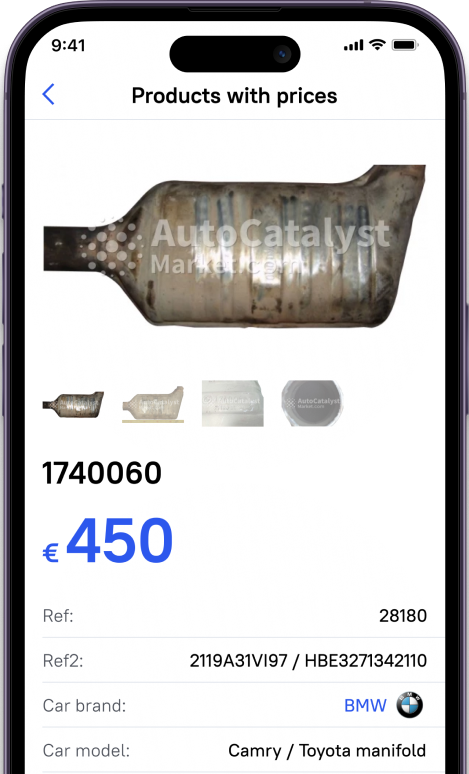- Symptoms of catalytic converter replacement
- Reduced motor performance
- Low pressure of exhaust gases
- Activation of Check Engine icon
- Why catalytic converter fails?
- Key reasons for catalytic converter failure to avoid:
In case you have not ever heard about such a part as a catalyst, then get impressed, because catalytic converter not only catches and neutralizes harmful compounds, but also directly affects operation of engine. Signals from the sensors located at the input and output of the catalyst are constantly read by the "brains" of the car and help to optimize the working mixture in the best way.
Usually life term of an expensive catalyst is usually approximately equal to the life term of a car itself, but often catalytic all convertor breaks much faster than it should and can drag motor along with it. It is important to remember that catalytic converter does not fail for no reason. Its breakdown is a sign of improper operation of ignition system, incomplete combustion of a mixture in the cylinders, severe motor fail or prolonged use of low-quality fuel.
Symptoms of catalytic converter replacement
Recycling of old catalytic converters is easy when there are reliable companies. They evaluate your catalyst and offer good compensation. To understand that your catalyst has to be removed and changed, you can take a look at several characteristic symptoms:
Reduced motor performance
Most common sign of catalyst failure is a severe decrease in power. Vehicle starts losing momentum and accelerates poorly. It overheats, when the catalyst capacity is greatly reduced: cells are destroyed, melted and sintered, clogging the hole and interfering with the free passage of exhaust gases. At initial stage of the malfunction, the car will accelerate to a relatively low speed, and when the case is started, motor starts hard, then “suffocate” and stall. Fuel efficiency is also noticeably deteriorating. There is also a sharp unpleasant odor.
A loud rumble under the bottom of the car indicates that active element of catalytic converter has begun to collapse and fall apart. Ceramic fragments under influence of exhaust gases randomly beat against walls of casing and create an unpleasant rumble. As a rule, this is most clearly manifested at increased speeds and during startup.
Low pressure of exhaust gases
If you bring your hand to exhaust pipe, you can feel the pulsation. Exhaust valves of cylinders work in turn. If exhaust flow is smooth and constant, this is a sure sign of a clogged catalyst. If you increase the speed, and then turn off the engine, exhaust gases will continue to create a pressure for a short time. Gases accumulated in the clogged pipe are released.
Activation of Check Engine icon
The most universal sign of catalytic converter failure is a system error that activates “engine trouble” icon. If this symptom occurs, you should immediately read the error code with the diagnostic scanner and fix the problem. If "brains" of the car detect incorrect indicators on oxygen sensors, they immediately notify driver about this, and at the same time transfer the motor control system to emergency mode. This is often accompanied by worsening dynamics and increased fuel consumption. Computer diagnostics in this case often detect errors P0420 (low catalyst throughput) or P0430
Why catalytic converter fails?
The failure of catalyst does not occur suddenly. With proper operation of all other systems, it serves faithfully for many years until the moment the vehicle is disposed. If your old catalytic converter has to be recycled, you almost certainly have to diagnose and repair the ignition or power system.
As a rule, the catalyst is destroyed due to incorrect operation of these two systems. With a faulty ignition system, fuel in one or more cylinders does not burn out completely, but enters the exhaust system. Heated catalyst is forced to burn out increased volumes of hydrocarbons that heat the cells to ultra-high temperatures, which leads to their sintering. Causes of major trouble can be spark plugs, coils, or high voltage wires. Similar failures are also caused by malfunction of nozzles.
Another common cause for catalyst problems is severe mechanical damage, leading to deformation of housing. It is important to remember that thin-walled cells easily crumble even with minor exertion. When leaving for off-road, it will be useful to take care of installing additional protection for the underbody of a car.
Untimely repair of catalytic converter is dangerous because small particles of ceramics can get through exhaust path directly into engine cylinders. Once there, they instantly scratch the walls of cylinders and completely disable motor. The turbine suffers from ceramic debris. Additional heating of exhaust tract leads to deformations of cylinder head and greatly reduces resource of a power unit.
Key reasons for catalytic converter failure to avoid:
-
Poor fuel quality. Most often it is with a low octane rating. System switches to late ignition. This causes mixture to burn out at the outlet and increase temperature of the exhaust gases.
-
Incorrect operation of ignition system (misfire). The fuel that is not burnt in one cylinder is immediately ignited and burned in catalytic converter.
-
Mechanical damage to catalytic converter. Increased vibration of a power unit and impacts on catalyst lead to crumbling of ceramic block.
-
Thermal shock. Instant cooling of a hot catalyst while overcoming a puddle, for example, can cause cracks in ceramic element.
-
Incorrect air-fuel mixture caused, for example, by a malfunction of oxygen sensor. The same effect will cause leaky, pouring nozzles.
-
Adding additives to gas. Cocktails from unverified manufacturers or impaired concentration can increase combustion temperature.
Latest designs with minimal toxicity are programmed to quickly warm up the catalytic converter. In case the situation has gone bad, do not wait long to minimize expenses to repair. Get rid of your old catalyst and get paid for It!





































